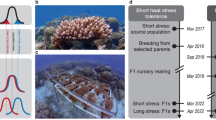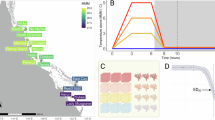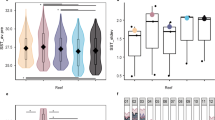Abstract
Standing genetic variation in fitness-related traits is critical to determine how fast populations can adapt to climate warming but is unknown for many species. Here we show that heritable genetic variation in heat tolerance in reef-building coral populations is widespread and strongly associated with selective pressure imposed by marine heatwaves. Our findings suggest that coral populations may be adapting to warming consistent with recent increases in their upper thermal limits.
This is a preview of subscription content, access via your institution
Access options
Access Nature and 54 other Nature Portfolio journals
Get Nature+, our best-value online-access subscription
$32.99 / 30 days
cancel any time
Subscribe to this journal
Receive 12 print issues and online access
$259.00 per year
only $21.58 per issue
Buy this article
- Purchase on SpringerLink
- Instant access to full article PDF
Prices may be subject to local taxes which are calculated during checkout


Similar content being viewed by others
Data availability
All data are available in the Supplementary Information, including the survival and settlement of coral larvae used in experiments and the thermal history of source populations.
References
Ainsworth, T. D. & Brown, B. E. Coral bleaching. Curr. Biol. 31, R5–R6 (2021).
Smith, K. E. et al. Biological impacts of marine heatwaves. Annu. Rev. Mar. Sci. 15, 119–145 (2023).
Hughes, T. P. et al. Spatial and temporal patterns of mass bleaching of corals in the Anthropocene. Science 359, 80–83 (2018).
Hughes, T. P. et al. Global warming transforms coral reef assemblages. Nature 556, 492–496 (2018).
Coleman, M. & Wernberg, T. The silver lining of extreme events. Trends Ecol. Evol. 35, 1065–1067 (2020).
Humanes, A. et al. Within-population variability in coral heat tolerance indicates climate adaptation potential. Proc. R. Soc. B 289, 20220872 (2022).
Naugle, M. S. et al. Heat tolerance varies considerably within a reef-building coral species on the Great Barrier Reef. Commun. Earth Environ. 5, 525 (2024).
Denis, H. et al. Thermal tolerance traits of individual corals are widely distributed across the Great Barrier Reef. Proc. R. Soc. B 291, 20240587 (2024).
Kirk, N. L., Howells, E. J., Abrego, D., Burt, J. A. & Meyer, E. Genomic and transcriptomic signals of thermal tolerance in heat‐tolerant corals (Platygyra daedalea) of the Arabian/Persian Gulf. Mol. Ecol. 27, 5180–5194 (2018).
Dziedzic, K. E., Elder, H., Tavalire, H. & Meyer, E. Heritable variation in bleaching responses and its functional genomic basis in reef‐building corals (Orbicella faveolata). Mol. Ecol. 28, 2238–2253 (2019).
Elder, H. et al. Genetic variation in heat tolerance of the coral Platygyra daedalea indicates potential for adaptation to ocean warming. Front. Mar. Sci. 9, 925845 (2022).
Howells, E. J. et al. Enhancing the heat tolerance of reef-building corals to future warming. Sci. Adv. 7, eabg6070 (2021).
Humanes, A. et al. Selective breeding enhances coral heat tolerance to marine heatwaves. Nat. Commun. 15, 8703 (2024).
Bairos-Novak, K. R., Hoogenboom, M. O., van Oppen, M. J. & Connolly, S. R. Coral adaptation to climate change: meta‐analysis reveals high heritability across multiple traits. Glob. Change Biol. 27, 5694–5710 (2021).
Howells, E. J., Bay, L. K. & Bay, R. in Coral Reef Conservation and Restoration in the Omics Age (eds van Oppen M. J. H. & Aranda, M.) 55–70 (Springer, 2022).
Diamond, S. E. Evolutionary potential of upper thermal tolerance: biogeographic patterns and expectations under climate change. Ann. N. Y. Acad. Sci. 1389, 5–19 (2017).
Liu, G. et al. Reef-scale thermal stress monitoring of coral ecosystems: new 5-km global products from NOAA Coral Reef Watch. Remote Sens. 6, 11579–11606 (2014).
Heron, S. F., Maynard, J. A., Van Hooidonk, R. & Eakin, C. M. Warming trends and bleaching stress of the world’s coral reefs 1985–2012. Sci. Rep. 6, 38402 (2016).
Howells, E. J., Abrego, D., Meyer, E., Kirk, N. L. & Burt, J. A. Host adaptation and unexpected symbiont partners enable reef‐building corals to tolerate extreme temperatures. Glob. Change Biol. 22, 2702–2714 (2016).
Burt, J. A., Paparella, F., Al-Mansoori, N., Al-Mansoori, A. & Al-Jailani, H. Causes and consequences of the 2017 coral bleaching event in the southern Persian/Arabian Gulf. Coral Reefs 38, 567–589 (2019).
Sully, S., Burkepile, D. E., Donovan, M., Hodgson, G. & Van Woesik, R. A global analysis of coral bleaching over the past two decades. Nat. Commun. 10, 1–5 (2019).
Shlesinger, T. & van Woesik, R. Oceanic differences in coral-bleaching responses to marine heatwaves. Sci. Total Environ. 871, 162113 (2023).
Hughes, T. P. et al. Emergent properties in the responses of tropical corals to recurrent climate extremes. Curr. Biol. 31, 5393–5399 (2021).
Marzonie, M. R. et al. The effects of marine heatwaves on acute heat tolerance in corals. Glob. Change Biol. 29, 404–416 (2023).
Denis, H. et al. Thermal tolerance traits of individual corals are widely distributed across the Great Barrier Reef. Proc. R Soc. B 291, 20240587 (2024).
Jin, Y. K. et al. Genetic markers for antioxidant capacity in a reef-building coral. Sci. Adv. 2, e1500842 (2016).
Fuller, Z. L. et al. Population genetics of the coral Acropora millepora: toward genomic prediction of bleaching. Science 369, eaba4674 (2020).
Baird, A. & Marshall, P. Mortality, growth and reproduction in scleractinian corals following bleaching on the Great Barrier Reef. Mar. Ecol. Prog. Ser. 237, 133–141 (2002).
Muller, E. M., Bartels, E. & Baums, I. B. Bleaching causes loss of disease resistance within the threatened coral species Acropora cervicornis. eLife 7, e35066 (2018).
McManus, L. C. et al. Evolution and connectivity influence the persistence and recovery of coral reefs under climate change in the Caribbean, Southwest Pacific, and Coral Triangle. Glob. Change Biol. 27, 4307–4321 (2021).
Sunday, J. M. et al. Evolution in an acidifying ocean. Trends Ecol. Evol. 29, 117–125 (2014).
Matz, M. V., Treml, E. A. & Haller, B. C. Estimating the potential for coral adaptation to global warming across the Indo‐West Pacific. Glob. Change Biol. 26, 3473–3481 (2020).
Wright, R. M. et al. Positive genetic associations among fitness traits support evolvability of a reef‐building coral under multiple stressors. Glob. Change Biol. 25, 3294–3304 (2019).
Lachs, L. et al. No apparent trade-offs associated with heat tolerance in a reef-building coral. Commun. Biol. 6, 400 (2023).
Baird, A. H. et al. An Indo-Pacific coral spawning database. Sci. Data 8, 35 (2021).
Madin, J. S. et al. The Coral Trait Database, a curated database of trait information for coral species from the global oceans. Sci. Data 3, 1–22 (2016).
Yakovleva, I. M. et al. Algal symbionts increase oxidative damage and death in coral larvae at high temperatures. Mar. Ecol. Prog. Ser. 378, 105–112 (2009).
Hadfield, J. MCMCglmm course notes. Github https://github.com/jarrodhadfield/MCMCglmm/blob/master/vignettes/CourseNotes.pdf (2019).
de Villemereuil, P. Estimation of a Biological Trait Heritability Using the Animal Model: How to Use the MCMCglmm R Package (2012); https://devillemereuil.legtux.org/wp-content/uploads/2012/12/tuto_en.pdf
de Villemereuil, P., Gimenez, O. & Doligez, B. Comparing parent–offspring regression with frequentist and Bayesian animal models to estimate heritability in wild populations: a simulation study for Gaussian and binary traits. Methods Ecol. Evol. 4, 260–275 (2013).
De Villemereuil, P., Schielzeth, H., Nakagawa, S. & Morrissey, M. General methods for evolutionary quantitative genetic inference from generalized mixed models. Genetics 204, 1281–1294 (2016).
de Villemereuil, P. How to Use the QGglmm Package? (R Project, 2020).
Daily global 5km satellite coral bleaching heat stress monitoring. NOAA Coral Reef Watch https://coralreefwatch.noaa.gov/product/5km (2023).
AIMS Temperature Logger Program. Australian Institute of Marine Science https://apps.aims.gov.au/ts-explorer (2018).
Acknowledgements
We thank the following for assistance with fieldwork, coral spawning and larval experiments: G. Vaughan, D. McParland and A. Mihala at New York University Saadiyat Island; F. Sinniger Harii at the Sesoko Marine Research Station; J. Nielsen, G. Matthews, A. Severati and the National Sea Simulator Team at the Australian Institute of Marine Science; F. McGregor at Coral Bay Research Station; and M. Muniz Barreto and S.-H. Hung (Sandy) at King Abdullah University of Science and Technology. This research was supported by a University of Wollongong Vice-Chancellor’s Postdoctoral Research Fellowship (E.J.H.), a Hermon Slade Foundation Grant (E.J.H. and D.A.) and a King Abdullah University of Science and Technology Competitive Research Grant (M.A. and E.J.H.).
Author information
Authors and Affiliations
Contributions
E.J.H. designed the study. E.J.H., D.A., E.P.-S. and S.S.-R. undertook fieldwork, coral breeding and experiments. H.D. provided the environmental data. J.A.B., S.H., L.K.B. and M.A. provided resources. E.J.H. and K.M. analysed the data. E.J.H. wrote the paper with contributions from all authors.
Corresponding author
Ethics declarations
Competing interests
The authors declare no competing interests.
Peer review
Peer review information
Nature Climate Change thanks the anonymous reviewers for their contribution to the peer review of this work.
Additional information
Publisher’s note Springer Nature remains neutral with regard to jurisdictional claims in published maps and institutional affiliations.
Supplementary information
Supplementary Tables 1–6
Supplementary Table 1. Survival of larval families of the brain coral, P. daedalea, from quantitative breeding experiments across the Indo-Pacific. Supplementary Table 2. Quantitative genetic parameters for the heat survival of larval families of the brain coral, P. daedalea, in populations across the Indo-Pacific. Supplementary Table 3. Summary of thermal history variables for populations of the brain coral, P. daedalea, sampled across the Indo-Pacific. Supplementary Table 4. Thermal history predictors of additive genetic variation (VA) for heat survival in populations of the brain coral, P. daedalea, across the Indo-Pacific. Supplementary Table 5. Survival and settlement of larval families of the brain coral, P. daedalea, from a quantitative breeding experiment in a Great Barrier Reef population. Supplementary Table 6. Quantitative genetic parameters for multiple traits of larval families of the brain coral, P. daedalea, in a Great Barrier Reef population.
Rights and permissions
Springer Nature or its licensor (e.g. a society or other partner) holds exclusive rights to this article under a publishing agreement with the author(s) or other rightsholder(s); author self-archiving of the accepted manuscript version of this article is solely governed by the terms of such publishing agreement and applicable law.
About this article
Cite this article
Howells, E.J., Abrego, D., Schmidt-Roach, S. et al. Marine heatwaves select for thermal tolerance in a reef-building coral. Nat. Clim. Chang. 15, 829–832 (2025). https://doi.org/10.1038/s41558-025-02381-3
Received:
Accepted:
Published:
Issue date:
DOI: https://doi.org/10.1038/s41558-025-02381-3



